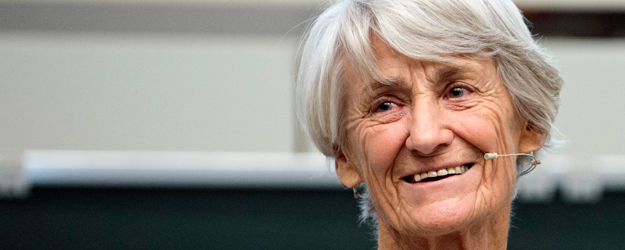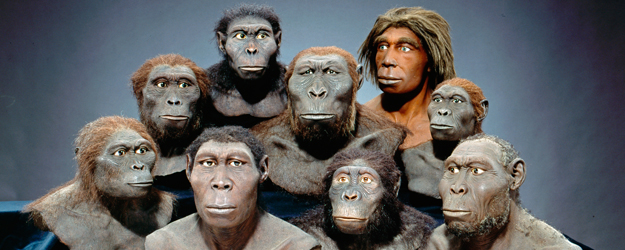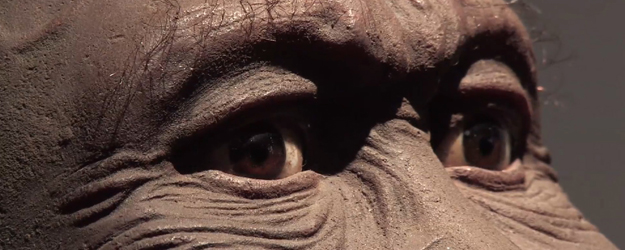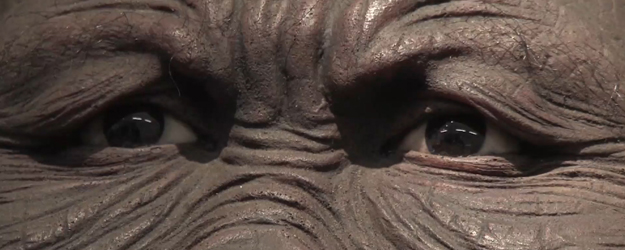16 June 2012
The famous British paleoanthropologist Meave Leakey came to Mainz at the invitation of Professor Friedemann Schrenk, holder of the 2012 Gutenberg Endowed Professorship. She gave a lecture at Johannes Gutenberg University Mainz (JGU) in which she reviewed six million years of human history. But before that, she met with her ancestors in the Mainz Museum of Natural History.
Meave Leakey came to Mainz both to see her forebears and talk about them. "I always call them my friends," says the Grand Old Dame of paleoanthropology as she stands before the display of hominids. The broad-faced Australopithecus boisei looks anything but friendly. However, the Neanderthal and the more small-boned Australopithecus africanus appear to be more laid-back, while the newcomer to the group, Kenyanthropus platyops, seems similarly relaxed. Leakey has a special relationship with him.
Although these are only reconstructions of the appearance of prehistoric and early humans housed in the Museum of Natural History in Mainz, the nine busts do seem convincingly true to life. Each single hair has been individually inserted, their glass eyes sparkle and the countless wrinkles seem to bear witness to life's experiences.
Hominid family album
It was Friedemann Schrenk who brought these splendid specimens to Mainz. As the 13th holder of the Johannes Gutenberg Endowed Professorship, the paleoanthropologist was not satisfied with just talking about the long road of hominization in his lecture series "Out of Africa: Towards a Global History of Homo sapiens." He took the decision to do much more.
So he used his connections at the Hessian State Museum in Darmstadt, where eight of the heads had been put on display already in 1998. With the support of the Research Center Geocycles at JGU, a special exhibition entitled "Family Album – Our Ancestors as Guests in Mainz" has been mounted in which the eight busts, together with the new one, play the starring roles.
Six million years in Africa
Right at the opening of the exhibition, Schrenk takes the opportunity to play down the extraordinary realism of the reconstructions. "This is not necessarily what they really looked like when alive, but rather how we think they must have looked. There is no right or wrong here, just probabilities." However, it is very likely that the skin color shared by all the busts apart from that of the Neanderthal is accurate. "We only had dark-skinned ancestors. This is something that might surprise people when they come to the exhibition."
And, thanks to Schrenk's efforts, Meave Leakey is present as a guest at the opening ceremony, but at the museum on this morning, the 69-year-old decides to remain a bit in the background. In a few hours, however, she will be giving a lecture entitled "The human heritage: 6 million years of history in Eastern Africa" as part of the Johannes Gutenberg Endowed Professorship lecture series. Here she will also be discussing the role her family played in discovering this heritage ...
A continent with history
"People generally think that Africa does not have much in the way of history." Meave Leakey is determined to demonstrate that this is a misapprehension and that the continent actually has a very long history. "Even if we have no written records of what took place, it is tremendously important because it is everybody's history."
Yet the world remained skeptical when early fossil remains of man began to be found in Africa. Raymond Dart's discovery at Taung in 1924 was largely ignored. "People did not want African ancestors," explains Leakey.
In 1931, Meave Leakey’s father-in law, Louis Leakey, left on an expedition to the Olduvai Gorge in Tanzania. He was to be busy there for a long time. Again and again, he returned with his wife, Mary. And it was here that they found the remains of Australopithecus boisei, who turned out to be 1.7 million years old. "Louis was at first disappointed. He wanted to find something that was more similar to modern humans." He eventually succeeded as Homo habilis had also left his traces in the gorge. Homo habilis was seen as a likely ancestor of Homo sapiens, while Australopithecus boisei was assigned to another branch of the hominids' family tree.
New branches in the family tree
The young London zoologist Meave Epps met Richard Leakey, the son of Louis and Mary, in Nairobi in 1969. He invited her on an expedition to Lake Turkana in northern Kenya – with the result that the two married a year later. Lake Turkana still captivates Meave Leake. In 1994, she found the remains of the oldest known species of Australopithecus, Australopithecus anamensis, on its rocky shores. And in 1999, she discovered the skull of Kenyanthropus platyops. This was further evidence of how complex the hominids' family tree is. Schrenk even likes to speak of a 'family bush' in light of the findings.
Such fossils of early hominids have so far only been found in Africa. It was not until 1.7 to 1.4 million years ago that early humans managed to find their way to other parts of the world. "Africa is the key to our identity;" emphasizes Leakey. The cradle of humanity is clearly located in this continent. She thinks that Africans should be made more aware of this – and she has one wish: "I would be very happy if their awareness of this past would prevent Africans making the same mistake as Americans and Europeans."
Creating awareness of the past
Leakey maintains links with the place where she made her discoveries and has founded the Turkana Basin Institute. This is an educational and research center that actively involves local people in the search for their ancestors. The paleoanthropologist hopes that it will enhance their appreciation of their magnificent past. "The problem here is religion," she says. The literal interpretation of the Bible excludes the possibility of evolution.
However, despite such opposition, she believes progress has been made. Looking towards the future, she concludes, "The Africans could show us how to make the world a better place. But we still have a long way to go."




